The Cold War was a prolonged period of political and military tension between the Western Bloc, led by the United States, and the Eastern Bloc, led by the Soviet Union. This conflict lasted from the end of World War II in 1945 until the dissolution of the Soviet Union in 1991. Understanding its causes and effects is crucial for the AP World History: Modern exam.
Learning Objective
Studying the causes and effects of the Cold War for AP World History: Modern, you should aim to understand the ideological differences between capitalism and communism, key events that intensified tensions, the global impact on politics and economies, and how this conflict shaped contemporary international relations.
1. Ideological Differences

- Capitalism vs. Communism: At the heart of the Cold War was a profound ideological clash. The United States championed capitalism and liberal democracy, advocating for individual freedoms and market economies. Conversely, the Soviet Union promoted communism, emphasizing state control of the economy and the idea of a classless society. This fundamental opposition created an atmosphere of suspicion and hostility.
- Different Visions for Post-War World: After World War II, the U.S. envisioned a world characterized by democratic governance and free-market principles. In contrast, the USSR sought to expand communist influence, establishing a network of satellite states in Eastern Europe and supporting revolutionary movements worldwide. This divergence set the stage for conflict as each superpower attempted to export its ideology.
2. Historical Rivalries

- World War II Alliances: While the U.S. and USSR allied against Nazi Germany, their relationship was fraught with tension. The U.S. was wary of Stalin’s authoritarian regime and its ambitions in Eastern Europe, while the Soviets felt betrayed by the West’s delayed military actions against Germany. This historical backdrop of mistrust intensified post-war tensions.
- Russian Revolution: The Bolshevik Revolution of 1917 led to the establishment of a communist regime in Russia. The U.S. opposed this new government and even intervened in the Russian Civil War to support anti-Bolshevik forces. This early intervention fostered resentment and laid the groundwork for future antagonism.
3. Nuclear Arms Race

- Development of Nuclear Weapons: The use of atomic bombs on Hiroshima and Nagasaki in 1945 demonstrated the devastating potential of nuclear weapons. The U.S. emerged from WWII as the sole nuclear power, which alarmed the USSR. The Soviet Union successfully tested its own atomic bomb in 1949, marking the beginning of a dangerous arms race.
- Mutually Assured Destruction (MAD): The doctrine of MAD emerged as both superpowers amassed vast arsenals of nuclear weapons. The belief that any nuclear conflict would lead to total annihilation served as both a deterrent and a source of constant fear. The nuclear arms race drove significant military expenditures and technological innovations.
Examples
Example 1: Marshall Plan
The U.S. implemented the Marshall Plan to aid European recovery, countering Soviet influence and fostering economic stability in Western Europe.
Example 2: Cuban Missile Crisis
The Cuban Missile Crisis (1962) heightened tensions, bringing the world close to nuclear war and showcasing the dangers of superpower confrontations.
Example 3: Vietnam War
The Vietnam War (1955-1975) illustrated the U.S. commitment to containment, resulting in significant casualties and shaping American public opinion on military intervention.
Example 4: Space Race
The competition for technological supremacy during the Space Race led to significant advancements in science and technology, reflecting Cold War rivalries.
Example 5: Detente Era
The period of détente in the 1970s aimed to ease tensions through diplomacy, resulting in treaties like SALT but ultimately failing to end hostilities.
MCQs
Question 1
Which of the following events marked the beginning of the Cold War?
A) The Korean War
B) The Yalta Conference
C) The Cuban Missile Crisis
D) The Berlin Blockade
Correct Answer: D) The Berlin Blockade
Explanation: The Berlin Blockade (1948-1949) is widely considered a significant early event in the Cold War. It illustrated the growing tensions between the U.S. and the Soviet Union, as the USSR sought to exert control over Berlin while the U.S. and its allies responded with the Berlin Airlift, demonstrating the West’s commitment to countering Soviet aggression.
Question 2
What was the primary goal of the Truman Doctrine announced in 1947?
A) To promote economic recovery in Europe
B) To contain the spread of communism
C) To establish diplomatic relations with the USSR
D) To support decolonization efforts worldwide
Correct Answer: B) To contain the spread of communism
Explanation: The Truman Doctrine was a pivotal policy that aimed to contain communism by providing political, military, and economic assistance to countries threatened by Soviet influence. This doctrine justified U.S. intervention in various conflicts, marking a significant shift in American foreign policy toward a more active role in global affairs.
Question 3
Which of the following was a direct consequence of the Cold War on global politics?
A) The establishment of the United Nations
B) The emergence of a bipolar world order
C) The end of colonialism in Africa
D) The expansion of the European Union
Correct Answer: B) The emergence of a bipolar world order
Explanation: The Cold War resulted in a bipolar world order dominated by the U.S. and the Soviet Union. This division influenced international relations, alliances, and conflicts, as nations aligned with one of the superpowers, leading to a significant reshaping of global politics that persisted for decades.


